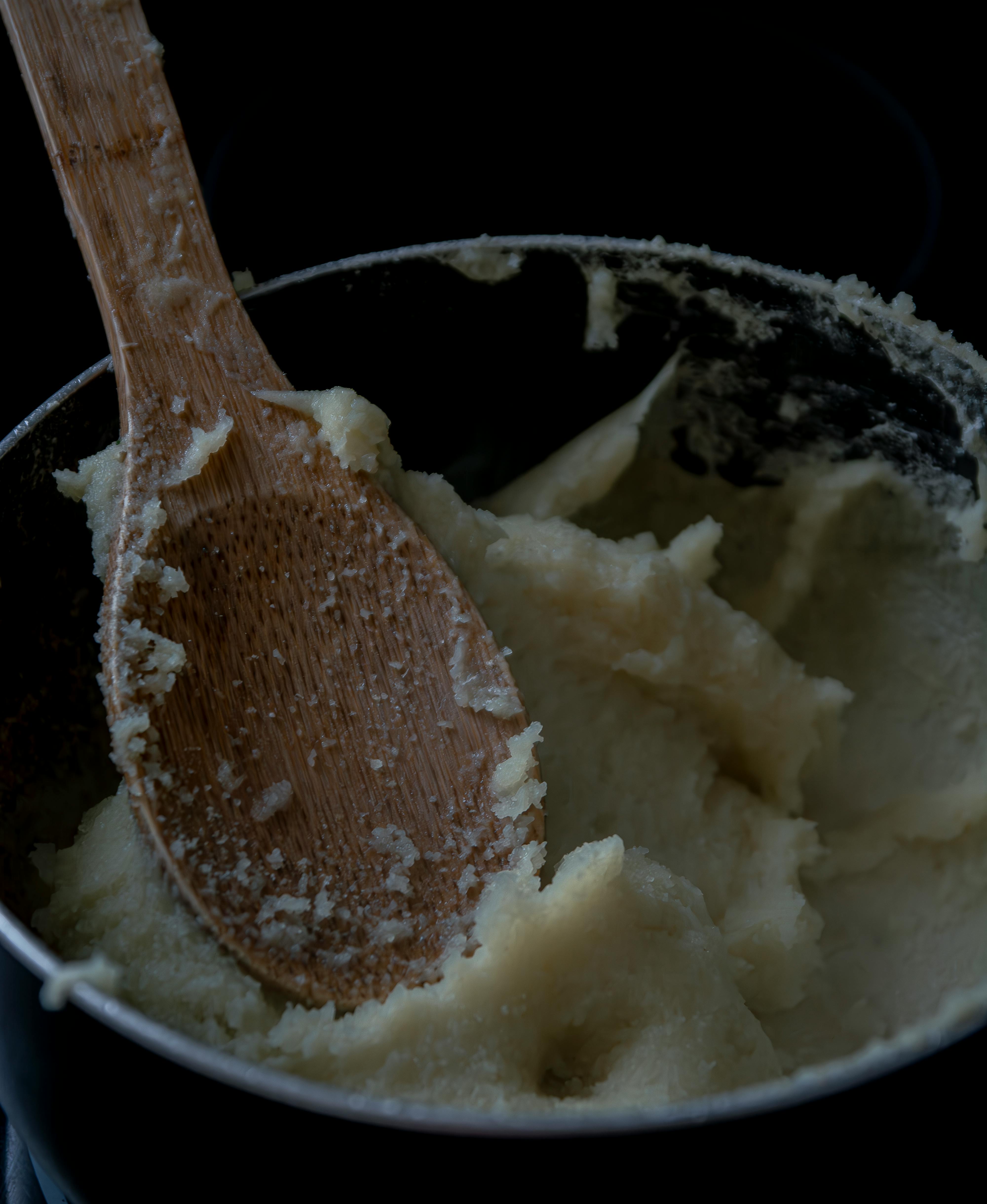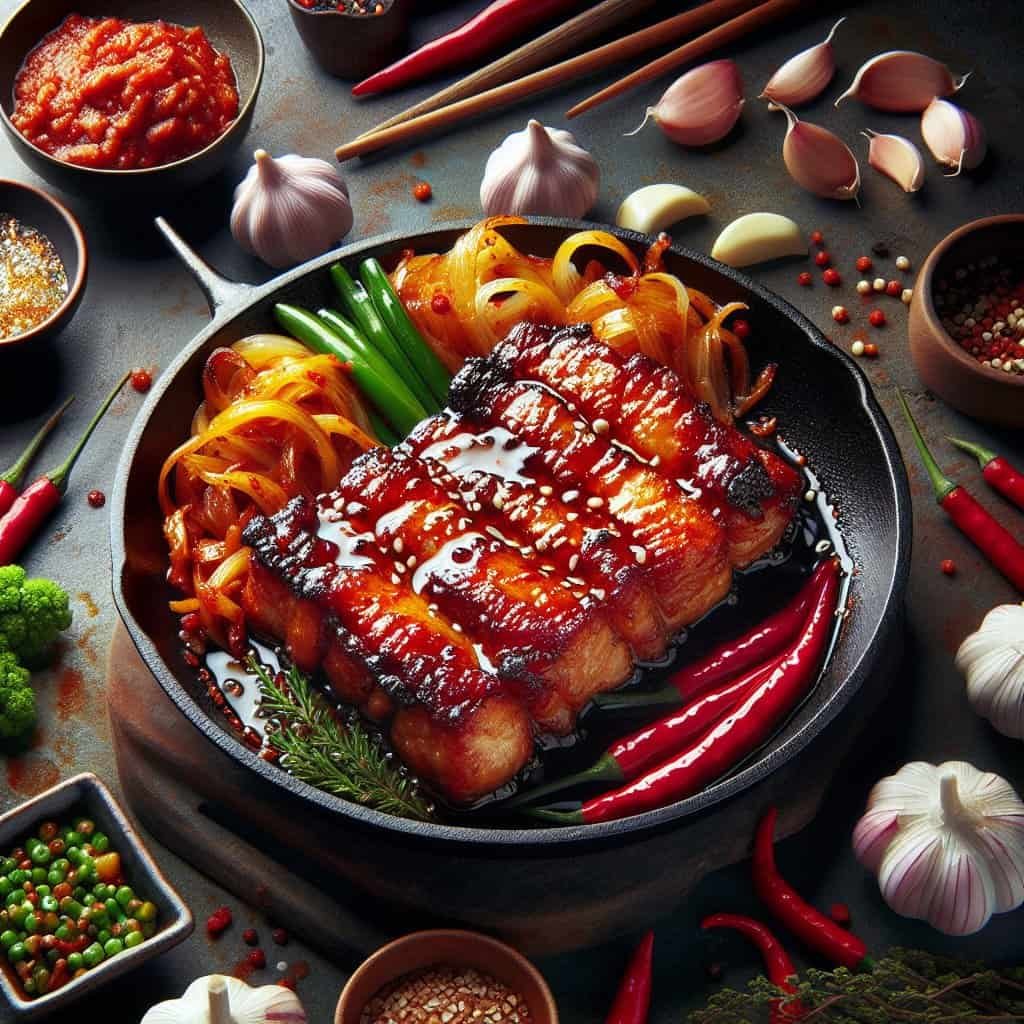Are you curious about the delicious flavors and aromatic spices of traditional Korean cuisine? Look no further than the famous dish of Dwaeji Bulgogi, a spicy stir-fried pork that will leave your taste buds dancing with delight. This mouthwatering dish is prepared by marinating thinly sliced pork in a blend of soy sauce, garlic, ginger, and Korean chili pepper paste, then cooked to perfection with various vegetables such as onions and mushrooms. The result is a tantalizing combination of sweet, savory, and spicy flavors that is sure to satisfy your cravings. Join us as we explore how this delectable dish is prepared and the delightful ways it is enjoyed in Korean culture.

Ingredients
To make a delicious traditional Korean spicy stir-fried pork, you will need the following ingredients:
Pork
The main component of this dish is pork. You can use pork belly, pork shoulder, or any other type of pork meat of your preference. The marbling and tenderness of the meat can greatly impact the final result.
Marinade
The marinade is what gives the pork its flavorful and spicy taste. It typically consists of soy sauce, gochujang (Korean chili paste), ginger, garlic, sesame oil, sugar, and black pepper. The combination of these ingredients creates a mouthwatering marinade that perfectly complements the pork.
Vegetables
Vegetables play a crucial role in adding freshness and texture to the dish. Traditional choices include onions, green onions, mushrooms, and bell peppers. These vegetables create a harmonious balance with the pork and marinade, enhancing both the taste and presentation of the dish.
Garnish
To add a final touch of flavor and visual appeal, garnishes are commonly used in Korean cuisine. Some popular options for garnishing dwaeji bulgogi include sesame seeds, sliced green onions, and chopped cilantro. These garnishes not only elevate the dish’s appearance but also add a delightful burst of freshness.
Now that we have our ingredients ready, let’s proceed to the next steps.
Marinating the Pork
Marinating the pork is a crucial step in infusing it with the rich flavors of the marinade. Here’s how you can do it:
Preparing the Pork
Start by rinsing the pork under cold water to remove any excess blood or debris. Pat it dry using a paper towel. Once dry, cut the pork into thin slices so that they can easily absorb the marinade. It’s essential to slice the meat thinly for optimum flavor absorption and tenderness.
Making the Marinade
In a bowl, combine the soy sauce, gochujang, minced ginger, minced garlic, sesame oil, sugar, and black pepper. Mix well until all the ingredients are fully incorporated. Adjust the seasoning to your taste preferences. The marinade should have a perfect balance of savory, spicy, and slightly sweet flavors.
Marinating the Pork
Place the sliced pork in a shallow dish or a ziplock bag. Pour the marinade over the pork, ensuring that all the slices are coated evenly. Massage the marinade into the meat, ensuring every slice is well-covered. Let the pork marinate in the refrigerator for at least 1 hour, though overnight marination is highly recommended for the most flavorful results.
With the pork marinating, let’s move on to preparing the vegetables.

Preparing the Vegetables
The vegetables in dwaeji bulgogi add freshness and variety to the dish. Here’s how to prepare them:
Slicing the Vegetables
Start by thinly slicing the onions, green onions, mushrooms, and bell peppers. These vegetables should be cut into similar-sized pieces for even cooking. Slicing the vegetables thinly allows them to cook quickly while retaining their crunchiness, balancing the tenderness of the marinated pork.
Precooking the Vegetables
To enhance the flavors of the vegetables, it’s recommended to quickly sauté or blanch them before stir-frying. Heat a small amount of oil in a pan and stir-fry the vegetables for a few minutes until they become slightly tender. Be careful not to overcook them, as they should retain some crispness for a pleasant texture.
Now that we have our pork marinated and vegetables prepared, it’s time to cook the dish.
Cooking the Dish
Cooking dwaeji bulgogi is an exciting process that involves a combination of techniques and careful attention. Let’s dive into the cooking process:
Heat the Pan
In a large, heated pan or wok, add a small amount of oil and heat it over medium-high heat. The pan should be hot enough to ensure proper and even cooking of the ingredients.
Cook the Marinated Pork
Add the marinated pork to the hot pan. Stir-fry the pork for about 5-7 minutes until it is cooked through and slightly caramelized. The savory aroma of the pork and the sizzling sound in the pan will surely get your taste buds excited.
Add the Vegetables
Once the pork is cooked, add the pre-cooked vegetables to the pan. Stir-fry everything together for an additional 2-3 minutes. This will allow the flavors of the vegetables to mingle with the marinade, creating a harmonious blend of tastes and textures.
Stir-frying
Continuously stir and toss the pork and vegetables together, ensuring even distribution of heat and flavors. The stir-frying process helps to infuse the flavors, while also ensuring that everything is cooked to perfection. Be careful not to overcook the ingredients to maintain their vibrant colors and crisp textures.
Now that our dish is ready, it’s time to add some final touches and get ready to serve and enjoy it.

Serving and Enjoying
Completing the final steps of presenting your dish is essential for creating an exceptional dining experience. Here’s what you need to do:
Garnishing
To enhance the visual appeal and flavor profile of your dwaeji bulgogi, sprinkle some sesame seeds, sliced green onions, or chopped cilantro as garnishes. These simple additions add a pop of color and freshness, making your dish even more enticing.
Serving Suggestions
Dwaeji bulgogi is typically served with a bowl of steamed rice and a variety of banchan (side dishes). Common banchan choices include kimchi, pickled vegetables, and spicy cucumber salad. The combination of these different elements creates a well-balanced and satisfying meal.
Pairing with Side Dishes
To further elevate your dining experience, you can also pair dwaeji bulgogi with other Korean side dishes such as japchae (stir-fried glass noodles), gochujang-based dishes like bibimbap or tteokbokki, or even some fresh lettuce leaves for wrapping the pork and vegetables for a light and refreshing twist.
With your dwaeji bulgogi prepared, it’s time to address some variations, tips, and commonly asked questions.
Variations and Tips
Here are some variations, substitutes, and tips you can consider to customize your dwaeji bulgogi preparation:
Spice Level
If you prefer milder flavors, you can reduce the amount of gochujang or adjust the spicy elements according to your taste. Similarly, if you’re a spice-lover, feel free to increase the amount of gochujang for an extra kick of heat.
Substitutes and Alternatives
While pork is the traditional choice for dwaeji bulgogi, you can experiment with different types of meat, such as beef or chicken. Each protein will bring its unique flavors and textures to the dish. Additionally, you can also incorporate other vegetables like carrots, zucchini, or bean sprouts to add more variety and nutrition.
Cooking Tips
To achieve the best results, make sure to slice the pork thinly, marinate it for a sufficient amount of time, and maintain the heat in the pan during the cooking process. High heat allows for a quick and even sear, resulting in tender and juicy pork slices. Additionally, avoid overcrowding the pan to prevent the ingredients from steaming rather than stir-frying.
Now that you know how to prepare dwaeji bulgogi, let’s explore its potential health benefits.

Health Benefits
Dwaeji bulgogi offers several health benefits due to its nutritious ingredients. Here are some key benefits:
Lean Protein
Pork, especially lean cuts like pork tenderloin, is an excellent source of high-quality protein. It provides essential amino acids that support muscle growth and repair, making it a great option for those looking to add more protein to their diet.
Antioxidant-rich Vegetables
The dish’s inclusion of various vegetables provides a range of vitamins, minerals, and antioxidants. These nutrients help support overall health, boost the immune system, and provide essential dietary fiber.
Digestive Benefits of Kimchi
Kimchi, a common side dish served with dwaeji bulgogi, contains probiotics that promote a healthy gut. These beneficial bacteria aid in digestion and enhance nutrient absorption, supporting optimal digestive health.
Now that we’ve covered the health benefits, let’s explore the cultural significance of dwaeji bulgogi.
Cultural Significance
Dwaeji bulgogi holds a special place in Korean cuisine and culture. Here are some aspects that highlight its cultural significance:
Traditional Korean Cuisine
Dwaeji bulgogi is deeply rooted in traditional Korean cuisine and represents the unique flavors and culinary traditions of the country. It showcases the perfect balance of savory, sweet, and spicy tastes, which are characteristic of Korean dishes.
Sharing and Bonding Over Meals
In Korean culture, sharing a meal is an important social activity that brings family and friends together. Dwaeji bulgogi is often prepared and enjoyed during gatherings, allowing people to connect, bond, and create lasting memories over a delicious meal.
Now, let’s address some frequently asked questions about dwaeji bulgogi.

Frequently Asked Questions
What is dwaeji bulgogi?
Dwaeji bulgogi, also known as spicy stir-fried pork, is a traditional Korean dish made with marinated pork, spicy and flavorful marinade, and a variety of vegetables. It is a beloved and iconic dish in Korean cuisine.
Can I use other types of meat?
Yes, while pork is the traditional choice, you can substitute it with other meats like beef or chicken. Each meat will bring its unique flavors and textures to the dish, allowing for a customized culinary experience.
How spicy is it?
The level of spiciness can be adjusted according to personal preference. Gochujang, the Korean chili paste used in the marinade, adds a moderate level of heat. However, you can increase or decrease the amount of gochujang to make the dish milder or spicier.
Conclusion
Dwaeji bulgogi, the spicy stir-fried pork, is a delightful and flavorful dish that represents the essence of traditional Korean cuisine. With its tender and well-marinated pork, a variety of fresh vegetables, and a perfect balance of spices, dwaeji bulgogi never fails to tantalize the taste buds. Whether enjoyed at a family gathering or as a comforting weeknight meal, this dish brings people together and creates lasting memories. So why not gather your loved ones, prepare some dwaeji bulgogi, and experience the rich cultural and culinary heritage of Korea in your own kitchen?
